Digital written-word sources
Digital sources such as Web sites differ from print sources in the ease with which they can be changed, updated, or eliminated. In addition, the various electronic media do not organize their works the same way. The most commonly cited electronic sources are documents from Web sites and databases. For help determining which is which, see 49a.
35. work from a database. The basic format for citing a work from a database appears in the source map on pp. 428–29.
For a periodical article that is available in print but that you access in an online database through a library subscription service such as Academic Search Premier, begin with the author’s name (if given); the title of the work, in quotation marks; the title of the periodical, italicized; and the volume / issue number and the date for the print version of the work (see models 28–34). Include the page numbers from the print version; if no page numbers are available, use n. pag. Then give the name of the online database, italicized; the medium (Web); and your most recent date of access.
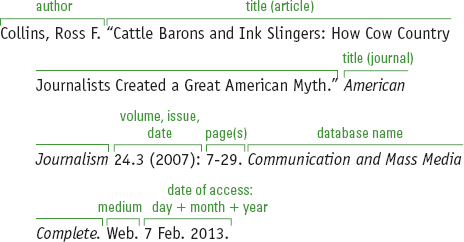
36. article from the web site of a journal. Begin an entry for an online journal article as you would one for a print journal article (see model 28). If an article does not have page numbers, use n. pag. End with the medium consulted (Web) and the date of access.
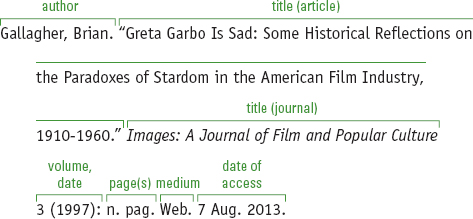
37. article in a magazine on the web. See model 29 for print publication information if the article appears in print. After the name of the magazine, give the sponsor of the Web site, the date of publication, the medium (Web), and the date of access.

38. article in a newspaper on the web. After the name of the newspaper, give the publisher, publication date, medium (Web), and access date.
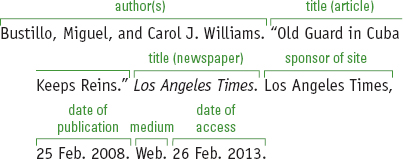
39. book on the web. Provide information as for a print book (see models 6–27); then give the name of the Web site, the medium, and the date of access.
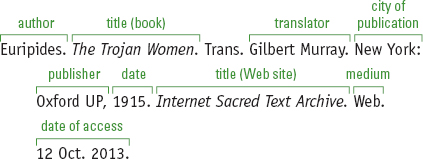
Note: Cite a part of an online book as you would a part of a print book (see models 10 and 21). Give the print publication information (if any), the name of the site, the medium (Web), and the date of access.
Riis, Jacob. “The Genesis of the Gang.” The Battle with the Slum. New York: Macmillan, 1902. N. pag. Bartleby.com: Great Books Online. Web. 31 Mar. 2013.
40. poem on the web. Include the poet’s name, the title of the poem, and the print publication information (if any) as you would for part of an online book (model 39). End with the name of the site, the medium (Web), and the date of access.
Dickinson, Emily. “The Grass.” Poems: Emily Dickinson. Boston, 1891. N. pag. Humanities Text Initiative American Verse Project. Web. 6 Jan. 2012.
41. editorial or letter in a web periodical. Include the word Editorial or Letter after the author (if given) and title (if any). End with the periodical name, the sponsor of the Web site, the date of the posting or most recent update, the medium, and the access date.
“The Funding Gap.” Editorial. Washington Post. Washington Post, 5 Nov. 2003. Web. 19 Oct. 2012.
Moore, Paula. “Go Vegetarian.” Letter. New York Times. New YorkTimes, 25 Feb. 2008. Web. 25 Feb. 2013.
42. review in a web periodical. Cite an online review as you would a print review (see model 33). End with the name of the periodical, the sponsor, the date of electronic publication, the medium, and the date of access.
Seitz, Matt Zoller. “A Modern Horror Film.” Rev. of The Social Network, dir. David Fincher. Salon. Salon Media Group, 4 Oct. 2010. Web. 24 May 2013.
43. entry in a web reference work. Cite the entry as you would an entry from a print reference work (see model 22). Follow with the name of the Web site, the sponsor, the date of publication, the medium, and the date of access.
“Tour de France.” Encyclopaedia Britannica Online. Encyclopaedia Britannica, 2006. Web. 21 May 2012.
44. work from a web site. For basic information on citing a work from a Web site, see the source map on pp. 434–35. Include all of the following elements that are available: the author; the title of the work in quotation marks; the name of the Web site, italicized; the name of the publisher or sponsor (if none is available, use N.p.); the date of publication (if not available, use n.d.); the medium (Web); and the date of access.
“America: A Center-Left Nation.” Media Matters for America. Media Matters for America, 27 May 2009. Web. 31 May 2011.
Stauder, Ellen Keck. “Darkness Audible: Negative Capability and Mark Doty’s ‘Nocturne in Black and Gold.’” Romantic Circles Praxis Series. U of Maryland, 2003. Web. 28 Sept. 2013.
45. downloaded pdf file. If you download a PDF file instead of reading the source online, determine what kind of source it is (such as a journal article) and give the information for citing such a source. Use PDF file as the medium; omit the access date.
Christenson, Clayton M., David Skok, and James Allworth. “Be the Disruptor.” Nieman Reports 66.3 (2012): 8-23. PDF file.
46. entire web site. Follow the guidelines for a specific work from the Web, beginning with the name of the author, editor, compiler, director, narrator, or translator, followed by the title of the Web site, italicized; the name of the sponsor or publisher (if none, use N.p.); the date of publication or last update; the medium of publication (Web); and the date of access.
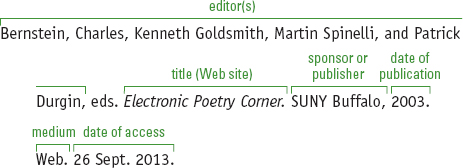
Weather.com. Weather Channel Interactive, 2011. Web. 13 Mar. 2012.
For a personal Web site, include the name of the person who created the site; the title or (if there is no title) a description such as Home page, not italicized; the name of the larger site, if different from the personal site’s title; the publisher or sponsor of the site (if none, use N.p.); the date of the last update; the medium of publication (Web); and the date of access.
Ede, Lisa. Home page. Oregon State. Oregon State U, 2010. Web. 17 May 2013.
47. academic course web site. For a course site, include the name of the instructor, the title of the course in quotation marks, the title of the site in italics, the department (if relevant) and institution sponsoring the site, the date (or n.d.), the medium (Web), and the access date.
Creekmur, Corey K., and Philip Lutgendorf. “Topics in Asian Cinema: Popular Hindi Cinema.” University of Iowa. Depts. of English, Cinema, and Comparative Literature, U of Iowa, 2004. Web. 13 Mar. 2012.
For a department Web site, give the department name, the description Dept. home page, the institution (in italics), the site sponsor, the date (or n.d.), the medium (Web), and the access information.
English Dept. home page. Amherst College. Amherst Coll., n.d. Web. 5 Apr. 2013.
48. blog. For an entire blog, give the author’s name; the title of the blog, italicized; the sponsor or publisher of the blog (if there is none, use N.p.); the date of the most recent update; the medium (Web); and the date of access.
Little Green Footballs. Little Green Footballs, 23 Aug. 2012. Web. 23 Aug. 2012.
Note: To cite a blogger who writes under a pseudonym, begin with the pseudonym and then put the writer’s real name (if you know it) in square brackets.
Atrios [Duncan Black]. Eschaton. N.p., 27 June 2013. Web. 27 June 2013.
49. published interview. List the person interviewed; the title of the interview (if any) or the label Interview and the interviewer’s name, if relevant. Then provide information about the source, following the appropriate model.
Paretsky, Sara. Interview. Progressive. Progressive Magazine, 14 Jan. 2008. Web. 12 Feb. 2011.
Taylor, Max. “Max Taylor on Winning.” Time 13 Nov. 2000: 66. Print.
50. post or comment on a blog. Give the author’s name; the title of the post or comment, in quotation marks (if there is no title, use the description Web log post or Web log comment, not italicized); the title of the blog, italicized; the sponsor of the blog (if there is none, use N.p.); the date of the most recent update; the medium (Web); and the date of access.

51. entry in a wiki. Because wiki content is collectively edited, do not include an author. Treat a wiki as you would a work from a Web site (see model 44). Check with your instructor before using a wiki as a source.
“Fédération Internationale de Football Association.” Wikipedia. Wikimedia Foundation, 27 June 2011. Web. 27 June 2011.
52. posting to a discussion group or newsgroup. Begin with the author’s name and the title of the posting in quotation marks (or the words Online posting). Follow with the name of the Web site, the sponsor or publisher of the site (use N.p. if there is no sponsor), the date of publication, the medium (Web), and the date of access.
Daly, Catherine. “Poetry Slams.” Poetics Discussion List. SUNY Buffalo, 29 Aug. 2003. Web. 1 Oct. 2005.
53. posting to a social networking site. To cite a posting on Facebook or another social networking site, include the writer’s name, a description of the posting, the date of the posting, and the medium of delivery. (The MLA does not provide guidelines for citing postings on such sites; this model is based on the MLA’s guidelines for citing email.)
Ferguson, Sarah. Status update. 6 Mar. 2013. Facebook posting.
54. email or message on a social networking site. Include the writer’s name; the subject line, in quotation marks (for email); Message to (not italicized or in quotation marks) followed by the recipient’s name; the date of the message; and the medium of delivery (E-mail). (MLA style hyphenates e-mail.)
Harris, Jay. “Thoughts on Impromptu Stage Productions.” Message to the author. 16 July 2006. E-mail.
55. tweet. Include the writer’s real name, if known, with the user name (if different) in parentheses. If you don’t know the real name, give just the user name. Include the entire tweet, in quotation marks. End with date and time of message and the medium (Tweet).
